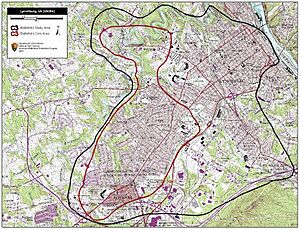Battle of Lynchburg facts for kids
Quick facts for kids Battle of Lynchburg |
|||||||
|---|---|---|---|---|---|---|---|
| Part of the American Civil War | |||||||
|
|||||||
| Belligerents | |||||||
| Commanders and leaders | |||||||
| David Hunter | Jubal Early | ||||||
| Strength | |||||||
| 16,643 | 14,000 | ||||||
| Casualties and losses | |||||||
| 700 killed, wounded, and missing (estimated) | 200 killed, wounded, and missing (estimated) | ||||||
The Battle of Lynchburg was a fight during the American Civil War. It happened on June 17 and 18, 1864, near Lynchburg, Virginia. The Union army, led by David Hunter, tried to take control of the city. But they were stopped by Confederate forces, led by Jubal Early. The Confederates won this battle.
Contents
Why Lynchburg Was Important
During the Civil War, Lynchburg was a very important city. It was a major place for supplies and a hospital center. The city also had key railroad lines. These railroads helped supply the Confederate States Army. Because of this, Union General David Hunter wanted to capture Lynchburg.
Hunter planned to attack Lynchburg. He hoped to get help from another Union general, Philip Sheridan. But Sheridan never arrived. He had faced a big loss at the Battle of Trevilian Station. This forced him to retreat to a different area.
Hunter also had trouble getting supplies. Confederate cavalry, led by John S. Mosby, kept attacking his supply lines. Between May 20 and June 17, only one supply wagon reached Hunter. This made it hard for his army to get what they needed.
Hunter's March to Lynchburg
On June 11, Hunter's forces fought Confederate cavalry near Lexington, Virginia. The Confederates, led by John McCausland, pulled back. Hunter waited for more of his cavalry to join him. While waiting, he burned the Virginia Military Institute. He also burned the home of John Letcher, who was a former governor of Virginia.
After more troops arrived, Hunter sent his cavalry to chase McCausland. McCausland burned a bridge over the James River to slow Hunter down. Hunter continued his march towards Lynchburg. His cavalry reached Liberty on the evening of June 15.
Meanwhile, Confederate generals were also moving. John C. Breckinridge sent cavalry to join McCausland. Breckinridge himself arrived in Lynchburg the next day. Other generals, Daniel Harvey Hill and Harry T. Hays, started building defenses. These defenses were in the hills southwest of the city.
That afternoon, McCausland's forces fought with Hunter's cavalry. The Confederates then retreated from New London.
The Battle Begins
General Jubal Early arrived in Lynchburg on June 17. He had been sent by General Robert E. Lee to help defend the city. A few hours later, Union cavalry met Confederate forces. The Confederates were dug in near the Quaker Meeting House. They were about four miles from Lynchburg.
The Union forces pushed the Confederates back. Two brigades of Confederate soldiers then set up defenses. They were around a strong fort, two miles from the city. This slowed the Union army's advance.
Hunter set up his headquarters at Sandusky House. He planned his attack on Early's defenses. That night, Hunter's troops heard sounds of trains. They also heard bugles and drums. The people of Lynchburg even made noise with bands and shouting. Their goal was to make the Confederate army seem much larger than it was.
Fighting on June 18
On June 18, more Confederate generals arrived. Early decided to stay on defense. He waited for the rest of his army to arrive. The fort, now known as Fort Early, was in the middle of the Confederate line. Other Confederate units were placed on the left and right sides. Even young cadets from the Virginia Military Institute were ready to fight.
Hunter still thought the Confederates were not that strong. He placed his divisions in front of the Confederate center. He also ordered an attack on the Confederate right side. Hunter looked for a weak spot in the Confederate lines. But the forts seemed too strong for a direct attack.
Hunter's cannons were set up and ready. Union forces tried to go around the Confederate left side. But they found it too difficult. The Confederates then attacked the Union center. The Union soldiers held their ground. After some fighting, the Confederates pulled back. They tried to break through the Union lines again. But they eventually retreated to their earthworks (dug-in defenses).
Meanwhile, the Confederate forces on the right held off the Union attacks. Both Hunter and his generals started to believe they were outnumbered. Early then prepared to launch his own attack. But Hunter decided to retreat as night fell.
After the Battle
After the battle, Early's army chased Hunter for three days. They covered about sixty miles. Then, Early stopped the chase. Hunter decided to move his army across the Shenandoah Valley into West Virginia.
The Battle of Lynchburg was very important for the Confederates. Hunter's retreat allowed Early to move freely up the Shenandoah Valley. Early's army then advanced into Maryland. They won a battle at Battle of Monocacy. They even reached the edge of Washington, D.C. before being stopped at the Battle of Fort Stevens.


